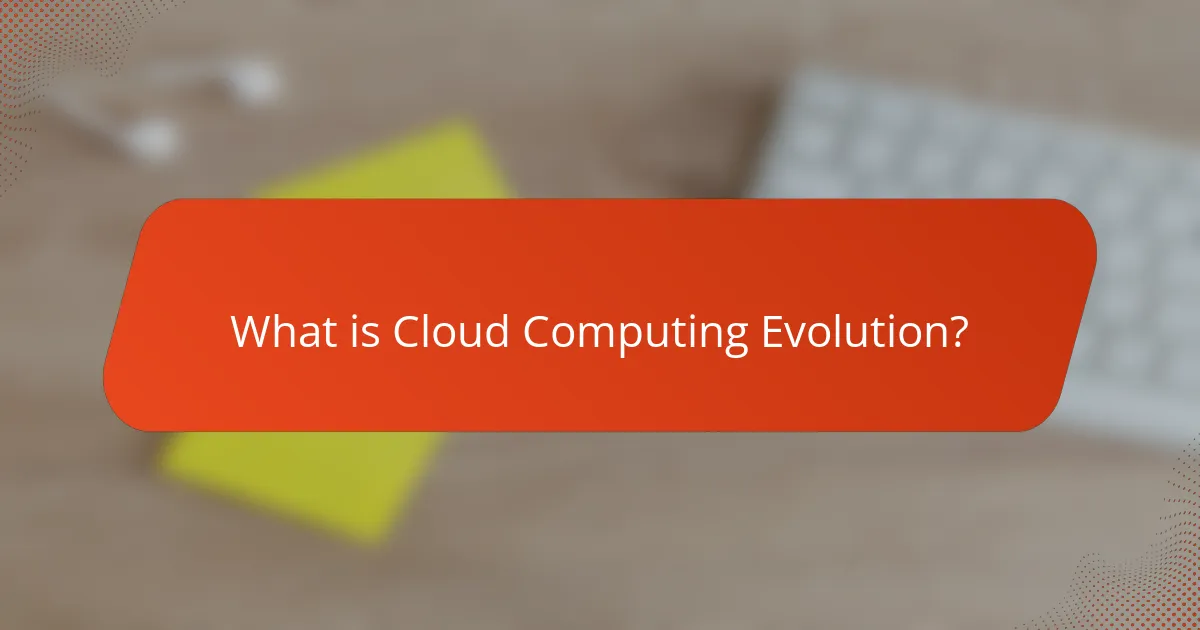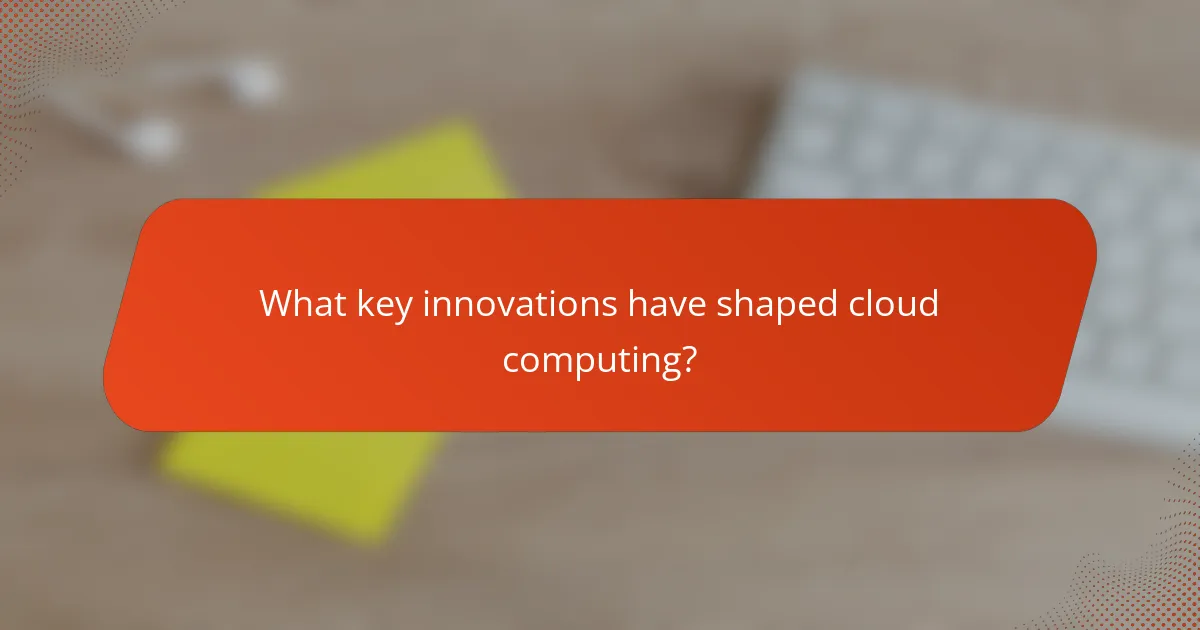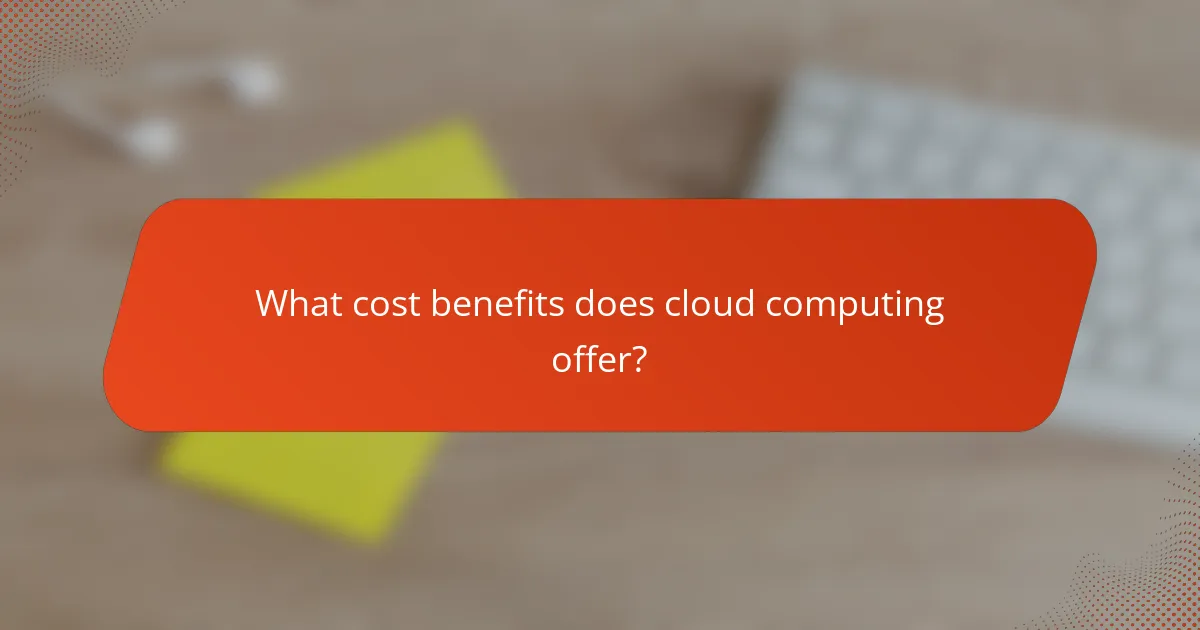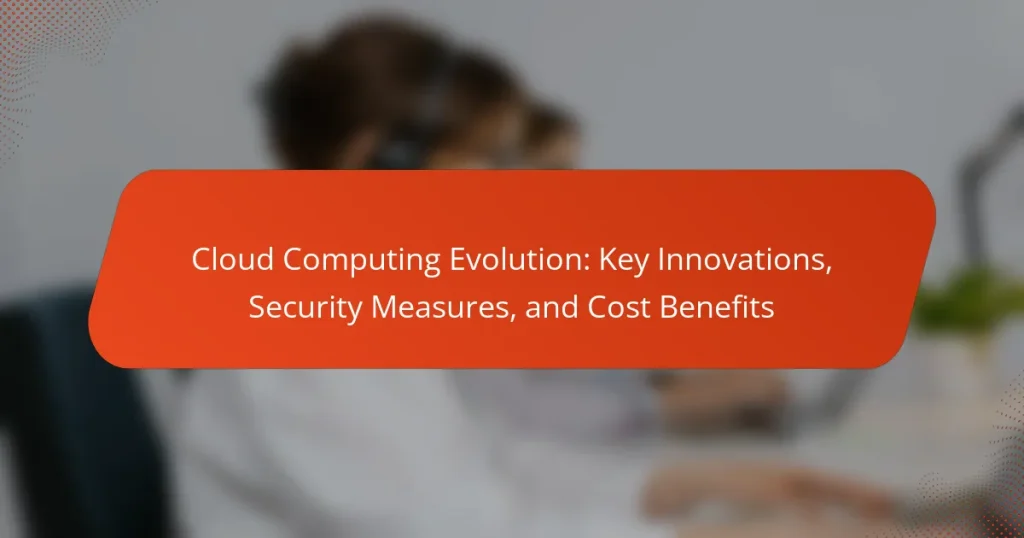Cloud computing evolution encompasses the ongoing advancements in cloud technologies and methodologies, tracing back to the 1960s with time-sharing systems and progressing through the emergence of application service providers in the 1990s. Key innovations such as virtualization, APIs, containerization, and serverless computing have significantly enhanced scalability, flexibility, and cost efficiency for businesses. Security measures, including data encryption, access control, and regular audits, are essential for protecting cloud resources. The financial benefits of cloud computing include reduced infrastructure costs and a pay-as-you-go model, which can lead to substantial savings for organizations. Overall, the article will explore these critical aspects of cloud computing evolution, highlighting its innovations, security protocols, and economic advantages.

What is Cloud Computing Evolution?
Cloud computing evolution refers to the progressive development of cloud computing technologies and methodologies. It began in the 1960s with the concept of time-sharing systems. The 1990s saw the emergence of application service providers, which offered software over the internet. In the 2000s, major companies like Amazon and Google popularized infrastructure as a service (IaaS) and platform as a service (PaaS). The evolution has led to increased scalability, flexibility, and cost-efficiency for businesses. According to Gartner, the global public cloud services market was expected to grow to $397.4 billion in 2021. This growth reflects the widespread adoption and continual innovation in cloud computing.
How has cloud computing transformed over the years?
Cloud computing has transformed significantly over the years. Initially, it started with basic storage solutions. Companies like Amazon Web Services launched in 2006, revolutionizing access to computing resources. Virtualization technology enabled multiple operating systems on a single server, optimizing resource use. The introduction of Software as a Service (SaaS) changed software delivery models. Organizations began to adopt public, private, and hybrid cloud environments for flexibility. Security measures have evolved, with encryption and compliance protocols becoming standard. According to Gartner, the global cloud services market grew to $270 billion in 2020, showcasing its impact. Today, cloud computing supports advanced technologies like artificial intelligence and machine learning, further enhancing its capabilities.
What are the key milestones in the evolution of cloud computing?
The key milestones in the evolution of cloud computing include the development of the concept in the 1960s, the introduction of virtual machines in the 1970s, and the launch of Salesforce.com in 1999. In 2006, Amazon Web Services (AWS) introduced Elastic Compute Cloud (EC2), marking a significant shift towards Infrastructure as a Service (IaaS). The term “cloud computing” gained popularity in 2007, following a presentation by Google CEO Eric Schmidt. In 2010, Microsoft launched Azure, expanding cloud services to a broader audience. The emergence of containerization technology, such as Docker in 2013, further advanced cloud computing capabilities. By 2020, multi-cloud strategies became prevalent, allowing organizations to leverage multiple cloud providers for flexibility and resilience. Each of these milestones has contributed to the growth and adoption of cloud computing as a fundamental technology in modern IT infrastructure.
How do technological advancements influence cloud computing’s evolution?
Technological advancements significantly influence cloud computing’s evolution by enhancing performance, scalability, and security. Innovations such as artificial intelligence and machine learning optimize resource management. These technologies enable predictive analytics, improving efficiency in cloud operations. Additionally, advancements in networking, such as 5G, increase data transfer speeds. This results in lower latency for cloud applications. Furthermore, developments in encryption techniques bolster data security in the cloud. Enhanced security measures build user trust and encourage adoption. Overall, these advancements drive the growth and transformation of cloud computing services.
What are the core components of cloud computing?
The core components of cloud computing include infrastructure, platforms, and software. Infrastructure refers to the physical and virtual resources required for cloud services. This includes servers, storage, and networking. Platforms provide a framework for developing, running, and managing applications. Software as a Service (SaaS) delivers applications over the internet. These components enable scalability, flexibility, and cost efficiency. According to the National Institute of Standards and Technology (NIST), these components are essential for cloud service models.
What types of cloud services are available?
There are three main types of cloud services available: Infrastructure as a Service (IaaS), Platform as a Service (PaaS), and Software as a Service (SaaS). IaaS provides virtualized computing resources over the internet. Users can rent servers and storage, allowing for scalability. PaaS offers a platform allowing developers to build, deploy, and manage applications without dealing with the infrastructure. SaaS delivers software applications over the internet on a subscription basis. This model eliminates the need for installation and maintenance. According to Gartner, the global cloud services market is expected to grow significantly, reflecting the increasing adoption of these models.
How do deployment models differ in cloud computing?
Deployment models in cloud computing differ primarily in their accessibility, management, and resource allocation. There are four main types: public, private, hybrid, and community clouds. Public clouds are owned by third-party providers and offer services over the internet. They are cost-effective and scalable but provide less control over data security. Private clouds are dedicated to a single organization, offering greater control and security but at a higher cost. Hybrid clouds combine both public and private elements, allowing for flexibility and resource optimization. Community clouds are shared among several organizations with common interests, promoting collaboration while maintaining some level of control. Each model addresses different business needs and regulatory requirements.

What key innovations have shaped cloud computing?
Virtualization technology has been a key innovation that shaped cloud computing. It allows multiple virtual machines to run on a single physical server. This maximizes resource utilization and reduces costs. Another significant innovation is the development of APIs. APIs enable seamless integration between cloud services and applications. This enhances flexibility and scalability for users. Furthermore, the adoption of containerization has transformed cloud deployment. Containers package applications and their dependencies together. This makes it easier to deploy and manage applications across different environments. Lastly, the rise of serverless computing has changed how developers build applications. It allows them to run code without managing servers. These innovations collectively have driven the rapid growth and adoption of cloud computing.
How do virtualization and containerization impact cloud computing?
Virtualization and containerization significantly enhance cloud computing by improving resource utilization and scalability. Virtualization allows multiple virtual machines to run on a single physical server. This optimizes hardware usage and reduces costs. Containerization, on the other hand, packages applications and their dependencies into isolated units. This enables faster deployment and consistency across different environments. Both technologies facilitate efficient scaling by allowing cloud services to quickly adapt to changing demands. According to a report by Gartner, organizations using virtualization can achieve up to 80% server utilization rates. Containerization further streamlines application development, leading to shorter release cycles. Together, they drive innovation and efficiency in cloud computing environments.
What role does virtualization play in resource management?
Virtualization significantly enhances resource management by enabling the efficient allocation of computing resources. It allows multiple virtual machines to run on a single physical server. This maximizes hardware utilization and reduces costs associated with physical infrastructure. Virtualization simplifies the management of resources through centralized control. Administrators can easily provision, scale, and decommission virtual resources as needed. According to a study by Gartner, organizations can achieve up to 70% server utilization rates with virtualization. This leads to reduced energy consumption and lower operational costs. Virtualization also improves disaster recovery and business continuity through easier backups and snapshots. Overall, virtualization is a key component in optimizing resource management within cloud computing environments.
How does containerization enhance application deployment?
Containerization enhances application deployment by enabling consistent environments across different stages of development. It isolates applications and their dependencies in lightweight containers. This isolation reduces conflicts between applications and simplifies the deployment process. Containers can run on any system that supports the container runtime, ensuring portability. According to a report by IBM, organizations using containerization can achieve 50% faster deployment times. This acceleration is due to the ability to quickly spin up or tear down containers as needed. Additionally, container orchestration tools like Kubernetes automate scaling and management, further streamlining deployment. This leads to improved resource utilization and reduced operational overhead. Overall, containerization fosters agility and efficiency in application deployment.
What are the latest trends in cloud technology?
The latest trends in cloud technology include multi-cloud strategies, serverless computing, and edge computing. Multi-cloud strategies allow organizations to use services from multiple cloud providers for flexibility and risk reduction. Serverless computing enables developers to build applications without managing infrastructure, leading to faster deployment and reduced costs. Edge computing processes data closer to the source, improving response times and bandwidth efficiency. According to a report by Gartner, the global public cloud services market is expected to grow by 18.4% in 2021, indicating a strong demand for these trends.
How do AI and machine learning integrate with cloud computing?
AI and machine learning integrate with cloud computing by leveraging cloud resources for data storage, processing power, and scalability. Cloud platforms provide the necessary infrastructure to run complex algorithms without local hardware limitations. This integration allows for real-time data analysis and model training using vast datasets. According to a report by Gartner, 75% of enterprise applications will leverage AI and machine learning by 2025, indicating a strong trend towards cloud-based solutions. Cloud computing also enables collaboration among data scientists and developers, facilitating the deployment of AI models. This synergy enhances the efficiency of machine learning workflows and reduces time-to-market for AI applications.
What is the significance of serverless computing?
Serverless computing is significant because it allows developers to build and run applications without managing server infrastructure. This model provides automatic scaling, meaning resources are allocated based on demand. It reduces operational costs, as users only pay for the compute time they consume. Serverless architectures enhance agility, enabling faster development and deployment cycles. Additionally, it supports microservices, promoting modular application design. According to a report by AWS, serverless computing can lead to a 60% reduction in infrastructure costs. This efficiency makes serverless computing an attractive option for businesses seeking to innovate rapidly.

What security measures are essential in cloud computing?
Essential security measures in cloud computing include data encryption, access control, and regular security audits. Data encryption protects sensitive information during transmission and storage. Access control ensures that only authorized users can access specific data and applications. Regular security audits help identify vulnerabilities and ensure compliance with security policies. Multi-factor authentication adds an additional layer of security by requiring multiple forms of verification. Network security measures, such as firewalls and intrusion detection systems, protect against external threats. Backup and disaster recovery plans ensure data availability in case of incidents. Implementing these measures is crucial for maintaining the integrity and confidentiality of cloud-based resources.
What are the common security threats faced by cloud services?
Common security threats faced by cloud services include data breaches, account hijacking, and insecure APIs. Data breaches occur when unauthorized individuals access sensitive information stored in the cloud. According to a 2021 report by IBM, the average cost of a data breach is $4.24 million. Account hijacking involves attackers gaining unauthorized access to user accounts, often through phishing or credential theft. Insecure APIs can expose cloud services to various attacks, as they may lack proper authentication and encryption measures. Additionally, denial-of-service attacks can disrupt cloud services by overwhelming them with traffic. These threats highlight the importance of implementing robust security measures in cloud computing environments.
How do data breaches occur in cloud environments?
Data breaches in cloud environments occur primarily due to inadequate security measures. These breaches can happen through various means, including misconfigured cloud settings. Research shows that 70% of cloud security failures are attributed to misconfiguration. Additionally, weak access controls can allow unauthorized users to gain access to sensitive data. Phishing attacks targeting cloud service credentials also contribute to breaches. Furthermore, vulnerabilities in third-party applications can expose cloud data. A report by the Cloud Security Alliance indicates that 90% of organizations experience cloud security incidents annually. These factors combined create a landscape where data breaches can easily occur in cloud environments.
What are the implications of inadequate security measures?
Inadequate security measures can lead to data breaches and unauthorized access. This results in sensitive information being exposed to malicious actors. Organizations may face significant financial losses due to theft or fraud. According to IBM’s Cost of a Data Breach Report, the average cost of a data breach is $4.35 million. In addition, inadequate security can damage an organization’s reputation and erode customer trust. Regulatory fines may also be imposed for non-compliance with security standards. Furthermore, recovery from a breach can be time-consuming and resource-intensive. Overall, the implications of inadequate security measures can be severe and far-reaching.
How can organizations enhance cloud security?
Organizations can enhance cloud security by implementing multi-factor authentication (MFA). MFA requires users to provide two or more verification factors to gain access. This significantly reduces the risk of unauthorized access.
Regularly updating software and security protocols is essential. Software vulnerabilities can be exploited by cyber attackers. Keeping systems updated minimizes these risks.
Data encryption is another critical measure. Encrypting data at rest and in transit protects sensitive information. Even if data is intercepted, it remains unreadable without the encryption key.
Conducting regular security audits helps identify vulnerabilities. Organizations can assess their security posture and address weaknesses proactively.
Training employees on security best practices is vital. Human error is a leading cause of security breaches. Educated employees are less likely to fall for phishing attacks.
Lastly, utilizing cloud security tools enhances protection. These tools can monitor for suspicious activity and automate threat responses. Implementing these strategies collectively strengthens an organization’s cloud security framework.
What best practices should be implemented for cloud security?
Implementing best practices for cloud security involves several key strategies. First, organizations should adopt a robust identity and access management (IAM) system. IAM ensures that only authorized users can access cloud resources. Second, data encryption should be employed for data at rest and in transit. This protects sensitive information from unauthorized access. Third, regular security audits and assessments are essential. They help identify vulnerabilities and ensure compliance with security policies. Fourth, organizations should implement multi-factor authentication (MFA). MFA adds an extra layer of security beyond just passwords. Additionally, continuous monitoring of cloud environments is crucial. It allows for the detection of anomalous activities in real-time. Finally, organizations should establish an incident response plan. This plan outlines steps to take in case of a security breach. These best practices collectively enhance the security posture of cloud environments.
How do compliance regulations affect cloud security strategies?
Compliance regulations significantly influence cloud security strategies by mandating specific security measures and protocols. Organizations must align their cloud security practices with regulations such as GDPR, HIPAA, and PCI DSS. These regulations require data encryption, access controls, and regular audits to protect sensitive information. Failure to comply can result in severe penalties, including fines and reputational damage. As a result, companies often invest in advanced security technologies to meet these regulatory demands. Compliance also drives the adoption of best practices in risk management and incident response planning. Overall, compliance regulations shape the framework within which cloud security strategies are developed and implemented.

What cost benefits does cloud computing offer?
Cloud computing offers significant cost benefits, primarily through reduced infrastructure expenses. Organizations save on hardware costs by utilizing shared resources in the cloud. This model eliminates the need for on-premises servers and maintenance.
Additionally, cloud computing operates on a pay-as-you-go basis. Companies only pay for the resources they use, which can lead to substantial savings. According to a study by Gartner, businesses can reduce IT spending by up to 30% by migrating to the cloud.
Furthermore, cloud solutions often include automatic updates and security features. This reduces the need for dedicated IT staff, further lowering operational costs. Overall, cloud computing provides a flexible and cost-effective solution for businesses.
How does cloud computing reduce operational costs?
Cloud computing reduces operational costs by minimizing the need for physical infrastructure. Organizations can avoid expenses related to hardware purchases and maintenance. They also benefit from scalable resources, paying only for what they use. This flexibility reduces waste and optimizes spending. Additionally, cloud services often include automatic updates and security features, lowering IT management costs. According to a study by Gartner, businesses can save up to 30% on their IT budgets by adopting cloud solutions. This financial efficiency is a key driver for cloud adoption across various industries.
What is the impact of pay-as-you-go pricing models?
Pay-as-you-go pricing models significantly lower upfront costs for users. This pricing structure allows customers to pay only for the resources they consume. As a result, it enhances financial flexibility for businesses. According to a study by Gartner, organizations can save up to 30% on IT costs by adopting this model. Additionally, it encourages efficient resource usage and scaling. Users can easily adjust their spending based on demand fluctuations. This adaptability is particularly beneficial for startups and small businesses. Overall, pay-as-you-go models drive innovation and cost efficiency in cloud computing.
How does cloud computing minimize infrastructure expenses?
Cloud computing minimizes infrastructure expenses by reducing the need for physical hardware and maintenance. Organizations can access scalable resources on-demand, eliminating upfront capital costs. This model allows businesses to pay only for the services they use. According to a study by Gartner, companies can save up to 30% on IT costs by adopting cloud solutions. Additionally, cloud providers handle maintenance and upgrades, further decreasing operational expenses. The flexibility of cloud services allows for quick adjustments to resource needs, optimizing cost efficiency.
What are the financial advantages of scalability in cloud computing?
Scalability in cloud computing provides significant financial advantages. It allows businesses to adjust resources based on demand, reducing costs associated with underutilization. Companies only pay for the resources they use, leading to lower operational expenses. This flexibility enables rapid scaling during peak times without upfront hardware investments. According to a report by Gartner, organizations can save up to 30% on IT costs by adopting scalable cloud solutions. Additionally, scalability helps in optimizing resource allocation, minimizing waste, and enhancing overall efficiency. This financial model supports growth without the burden of excessive fixed costs.
How does scaling resources impact cost efficiency?
Scaling resources directly enhances cost efficiency by optimizing resource utilization. When resources are scaled, organizations can adjust their capacity to match demand. This leads to reduced waste and lower operational costs. For instance, cloud services often operate on a pay-as-you-go model. Businesses only pay for the resources they use, avoiding the costs associated with over-provisioning. According to a report by Gartner, companies can save up to 30% on IT costs through effective resource scaling. Therefore, scaling resources is a critical strategy for improving financial efficiency in cloud computing environments.
What role does resource optimization play in cost savings?
Resource optimization significantly contributes to cost savings by enhancing the efficiency of resource usage. It minimizes waste and ensures that resources are allocated effectively. In cloud computing, this involves optimizing computing power, storage, and bandwidth. By using only what is necessary, companies can reduce operational costs. For instance, a study by Gartner found that organizations can save up to 30% on IT costs through resource optimization strategies. This approach not only cuts expenses but also improves performance and scalability.
What practical tips can organizations use to maximize cloud cost benefits?
Organizations can maximize cloud cost benefits by implementing several practical strategies. First, they should regularly analyze their cloud usage and costs. This helps identify underutilized resources. Second, organizations can use auto-scaling features to adjust resources based on demand. This prevents over-provisioning and saves costs. Third, they should consider reserved instances for predictable workloads. This option often provides significant discounts compared to on-demand pricing. Fourth, organizations can implement tagging for better resource tracking. This enables more accurate cost allocation and management. Fifth, leveraging cloud cost management tools can provide insights and recommendations. These tools help optimize spending and identify savings opportunities. Lastly, organizations should regularly review their cloud service agreements. This ensures they are taking advantage of the best pricing options available.
Cloud computing evolution encompasses the progressive development of cloud technologies, beginning in the 1960s and leading to significant advancements in scalability, flexibility, and cost-efficiency. Key milestones include the introduction of virtualization, the rise of Infrastructure as a Service (IaaS), and the emergence of serverless computing. The article also addresses essential security measures such as data encryption and access control, as well as the financial benefits of cloud computing, including reduced infrastructure expenses and optimized resource utilization. Additionally, it highlights the impact of technological innovations, such as AI and machine learning, on cloud capabilities and operational efficiency.




